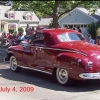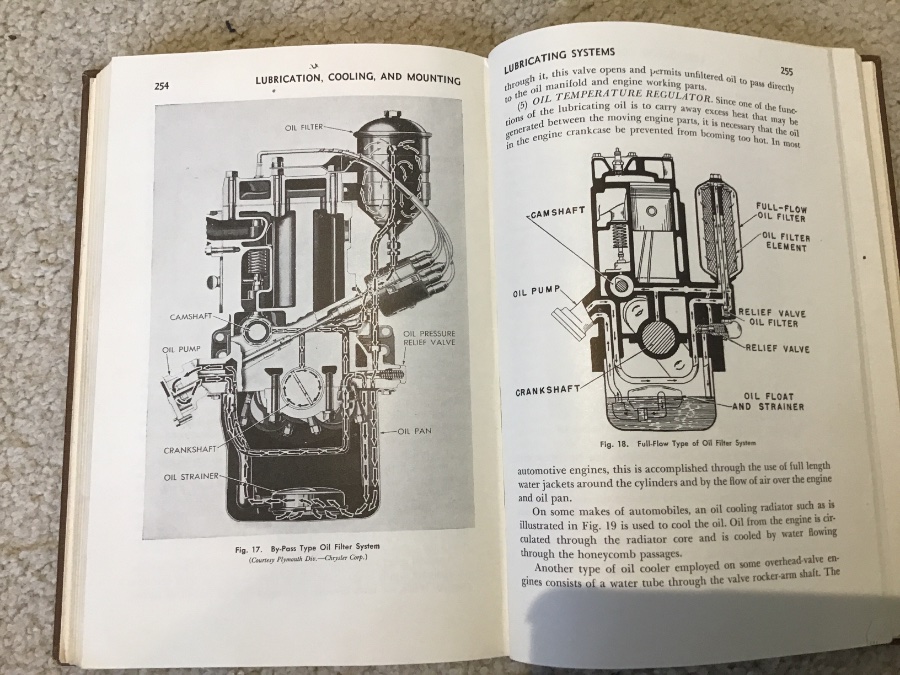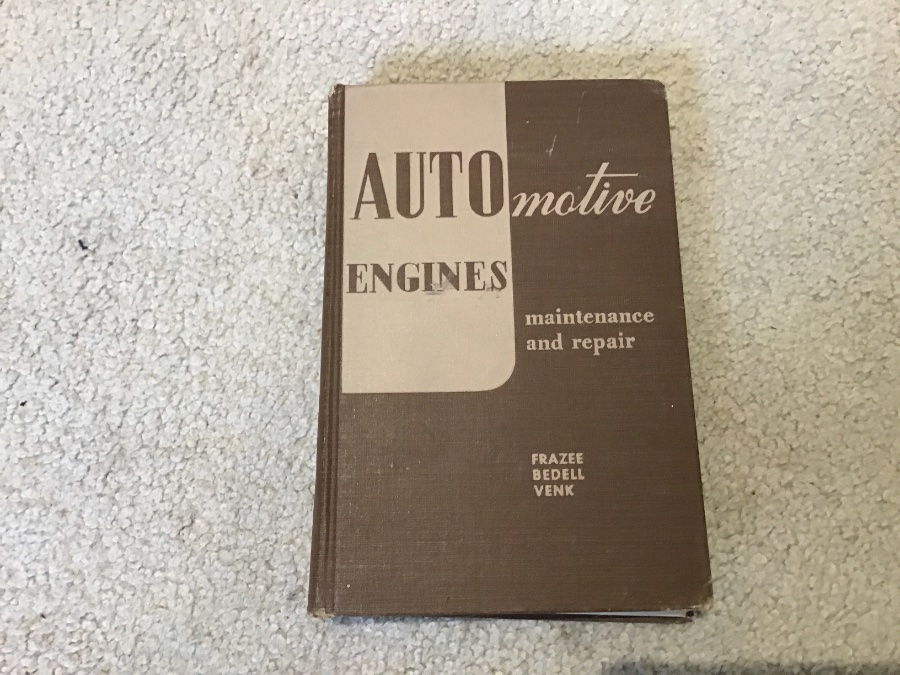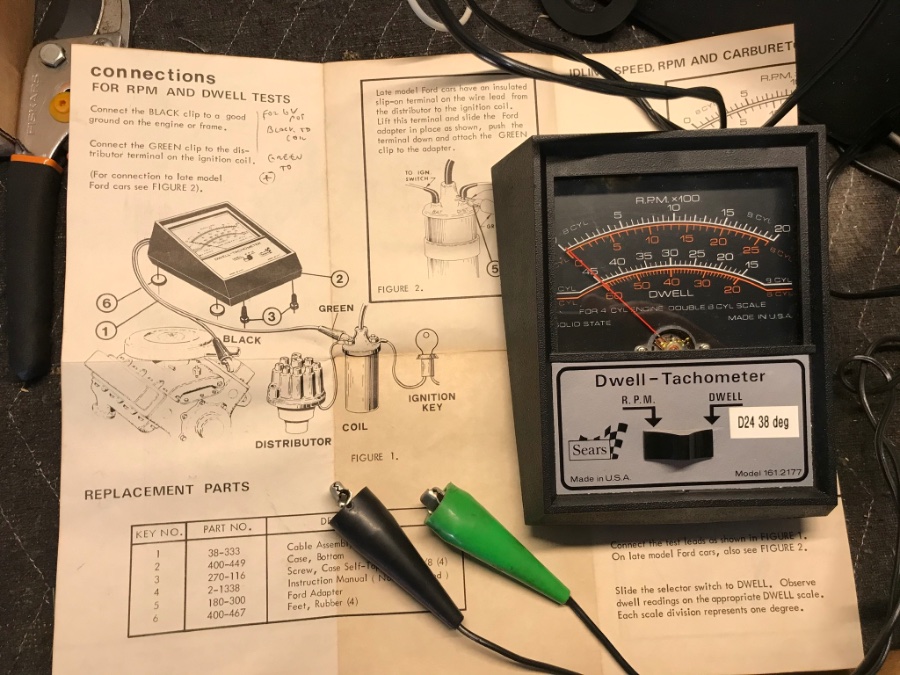-
Posts
1,230 -
Joined
-
Last visited
-
Days Won
6
Content Type
Links Directory
Profiles
Articles
Forums
Downloads
Store
Gallery
Blogs
Events
Everything posted by busycoupe
-
On the 47 Dodge the fluid drive is entirely separate from the transmission. Some Mopars from the early 50's had a transmision and coupling that shared oil.
-
There is an inspection cover under the front mat/carpeton the top right sideof the transmision hump. When you remove the cover you can see the fluid drive unit. The unit has two fill/drain ports on opposite sides of the unit. You need to turn motor either by bumping the starter or by turning the fan until one of the fill ports lines up with the inspection opening. Then you can use a socket wrench to open the fill port. Stuff a rag around the opening so that if you drop the plug it won't fall down in the bell housing out of reach. The fluid should be filled to the edge of the fill port. As Wagoneer says above, you should use Mobil 1 light recirculating fluid. However, I and many others have also used universal tractor fluid # 134. This is an iso 32 wt. hydraulic fluid and works in the fluid drive unit just fine. You can get it at Tractor Supply and many auto parts stores. Several years ago my 48 Dodge was slipping going up hill and I found I had to add 2 qts of fluid. It has been fine since.
-

'54 Savoy - Primary hood latch adjustment?
busycoupe replied to Fujisawa Rob's topic in P15-D24 Forum
It is difficult to diagnose without seeing it, but I would start by making sure that the cable and/or the catch mechanism is not binding. Make sure that the catch mechanism is lightly greased. Spray white lithiumgreese works well. -
Tod, you and I must be the same age. I started commuting to Northeastern University in Boston by car in the fall of 1970.
-
I'm pretty sure that the 5yr/50,000mi warranties were on the powertrain only, not bumper to bumper. Growing up in Massachusetts I remember most cars getting rust through in 2 or 3 years.
-
Good to know!
-
This forum is all about how to keep 60, 70 and 80 year old cars running. Most forum members drive their cars, or want to drive their cars; some as daily drivers. This led me to wonder .... what were the original manufacturer' warranties? Did they warranty their cars at all? I worked in service stations in the early 70's and our bread and butter was was replacing 2 year old batteries, exhaust systems, tires, brakes, etc. All of these were long out of warranty. What were the warranties like in the 1940's?
-

Thinking about getting this 49 Special Deluxe
busycoupe replied to JosephDR's topic in P15-D24 Forum
I applaud your idea of resurecting a 49 Plymouth, but please do not give it to your daughter. These cars were ok when they were built and everyone was driving the same type of car on poor roads and the usual speed driven around town was about 25 mph. Today with normal around town speeds of 40 to 50 mph these cars are death traps. They lack seat belts, crumple zones air bags, good suspension and brakes. To buy and fix up a 49 Plymouth to daily driver condition will probably cost between $5000 and $10000. For that money you can buy a road ready 10 to 15 yearold car that will serve your daughter much better. About 20 years ago my son, then about 20 yrs old, was riding with a friend in a nearly new Dodge Neon. The driver zigged when he should have zagged and drove into an abuttment on an elevated road in Boston, Ma. The car was totalled, but thanks to the air bags both young men walked away from the wreck with only a few bruises. I shudder to think what may have happened if they had been in a 70 year oldcollector car. Ok, I'll get off my soap box now. -
When I had my car painted I took the hoods off. When I put them back on I attached the chrome strip to the cowl support first then slid the hoods on one at a time, then fastened the front of the chrome strip in place. Ithink I used a small block of wood to hold up the front end the chrome strip while I inserted the hoods.
-
Punctuation is your friend.
- 1 reply
-
- 2
-

-
what do you mean by "cutting a piece out". Do the exhaust gases blow a hole in the exhaust donut gasket? If so, then there is somthing wrong with the way the pipe is seating into the manifold. Check the end of the pipe and how it slides onto the manifold, then fit a new gasket on it. The pipe should extend past the gasket slightly. Then make sure that flange bolts up squarely and securely to the manifold. I suspect that your exhaust pipe does not line up squarely to the manifold.
-
It looks like the short wire shown is for the high beam indcator in the middle. There should be two bulbs that light up the directional arrows and each would have a wire going to it.
-
Boat/marine supply stores: Bliss Marine, West Marine, are good sources for stainless hardware. It is usually in blister packs and expensive as the devil, but if you only need a few pieces and the marine store is going to save you a 30 mile trip it may be worth it.
-

My New Baby - D24 Bought from 101 Year Old WWII Veteran
busycoupe replied to tmorelli's topic in P15-D24 Forum
I agree with not trying to drain the fluiddrive, but you could check the fluid level in it. My 48 D24 started to slip in third gear a couple of years ago. When I checked the fluid level I found that it was low. I added 2 qts of tractor fluid and it has been running great since then. Apparently my fluid drive has a very slow leak. I have checked it twice since filling it and it has not lost a drop, but some how over 70 years it lost 2 qts. It is simple to check it, you may want check it before doing anything more intensive. -

Cool Finds: Parts, Tools, Literature etc.
busycoupe replied to maddmaxx1949's topic in P15-D24 Forum
-

Cool Finds: Parts, Tools, Literature etc.
busycoupe replied to maddmaxx1949's topic in P15-D24 Forum
Back when I was teaching High School, the auto shop teacher was cleaning out some old junk to make space to close half of the shop to be converted into classroom space. I thought that was a poor idea, especially because I ended up teaching science in the converted classroom that had no windows and a closet with the shop air compressor in it that would cycle on and off at random. One of the books he threw out was this 1951 textbook on engines. It has detailed information on how to make messurements, assess damage and wear, how to assemble and replace engines. All of it illustrated with annotated photos and diagrams of engines of the supplied by all of the major manufacturers. ... fascinating reading! -
My 1948 D24 has a rebuilt engine that has a block from a 1951 Plymouth. When I got it, it had an aluminum serial number plate riveted over the factory engine number. I suspect that the internal parts are from a Dodge 230 because my car has fluid drive, and the crank shaft and fly wheel are different from a Plymouth crank and fly wheel. Also, the head has a "T" cast into it. Is this from a truck engine? When I bought a rear main seal the catalog said that a 48 Dodge used a rope seal, but I had to get a bolt-on neoprene seal to fit the Plymouth block. It looks like the rebuilder was fast and loose with mixing and matching parts.
-
Before taking things apart check the point gap with a dwell meter and the timing. Thepoints may have slipped closed a little or the distributer could have slipped. Either would cause the symptons you describe.
-
Unpaved roads are very few and far between in Massachusetts. I ran into this one in the town of Westminster on the south side of Mt. Wachusett. The main road goes around the north side of the mountain to the ski resort, but this road is the road less travelled. It goes for a mile or two before connecting to very old, weathered pavement.
-
I have an old Sears dwell/tach that works off of the cars battery; no 9 volt battery involved. The instruction say that it is for 12V neg. ground, but it works fine on my 6V pos. ground '48 Dodge.
-
Make sure all of the connections in the starter circuit are clean and tight. Also, you can check the battery by turning on the headlights then try to crank the engine. If the lights go out immediately the battery is not up to snuff.
-
About 20 years ago I had a 1965 Ford Mustang. I wanted to have YOM plate on it and discovered that in the mid sixties Massachusetts only issued plates every other year. I ended up with a 1964 plate on the Mustang. I also had people thinking the car was a '64 model, or else telling me that I had the wrong year plate.
-
On my 1948 D24 the original engine number is stamped on the frame on the outside of the frame, just ahead of the driver side wheel arch; not on top of the frame. The serial number is stamped on a plate riveted to the driver side door jamb.
-
From the slot in that gasket it looks like the countershaft was expected to weep a little.
-
Several years ago my Dodge developed a noise that at first I thought was a knock. It would tick at idle when cold,but would quiet down when warmed up. I finally figured out that it had a crack in one of the exhaust manifold 'ears' where it bolted to the block. When cold there was a leak causing the tick, but when warmed up the crac closrd and all was quiet.






